Fighting machine flamethrower BMO-1
To simplify the development, construction and operation of flamethrower fighting vehicles were created on the basis of existing serial models of armored vehicles. Thus, the basis for the BMO-T was the serial tank T-72, and the BMO-1 was built on the basis of the infantry fighting vehicle BMP-2. In the case of a light machine for flamethrowers, there was a minimal change in the existing design, which made it possible to maintain a high degree of unification with the base sample. At the same time, the BMO-1 machine was proposed to be completed with a set of special equipment and weapons, providing a solution to a number of new tasks.
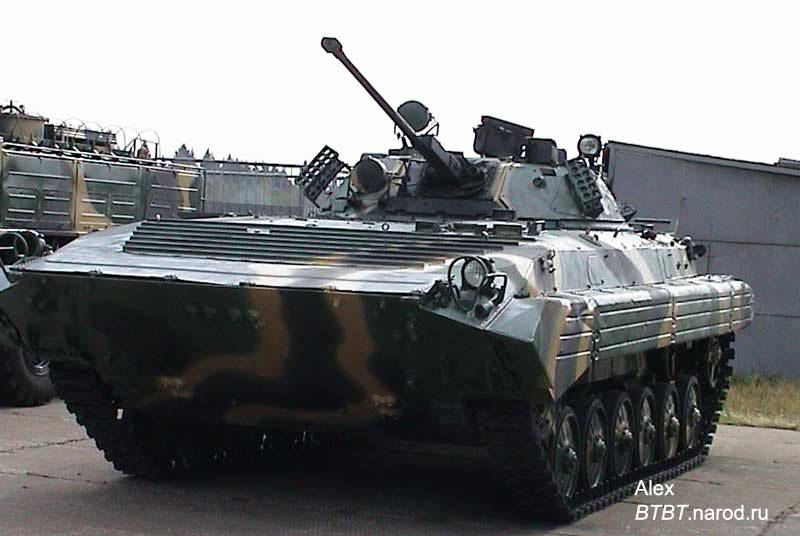
General view of the BMO-1 flamethrower combat vehicle. Photo Btvt.narod.ru
The development of the BMO-1 project was carried out by specialists from two organizations of the Russian defense industry. The armament complex of the advanced machine was created at the Design Bureau of Instrument Engineering (Tula), and the modifications of the base infantry machine were carried out by the Omsk Transport Engineering Design Bureau (now the Omsk Transport Engineering Plant). Together, the designers of the two offices formed the look of a promising machine, and also developed a technical design and presented the required equipment to the customer.
As the basis for a light combat vehicle, flamethrower was chosen an existing armored vehicle type BMP-2. This model of equipment has long been in service and is the most widespread representative of its class in the Russian armed forces, which, apparently, determined the choice of the authors of the BMO-1 project. Such a choice had a significant impact on the characteristics of the finished BMO-1. It was decided not to make major changes to the design of the chassis and combat compartment, which allowed to keep the basic parameters of the two combat vehicles on the same level. Simultaneously, the installation of a number of new systems was to lead to a change in the tactical role of the armored vehicle.
The BMO-1 project retained the existing corps of the infantry fighting vehicle BMP-2. The machine body is made of steel rolled homogeneous armor with a thickness of up to 19 mm. Any means of enhancing protection such as combining materials or exploding armor plates are not used. Like the prototype machine, the BMO-1 retained protection from small arms bullets and shell fragments. The shape of the case remains the same. There is a large upper frontal sheet that serves as the engine compartment cover and is connected to the bottom with an inclined lower part. The sides of the machine have a vertical bottom and an inclined upper part. Also in the body are used horizontal roof and bottom. The stern leaf is mounted with a slight backward slope and has two large openings for the installation of doors.
The layout of the existing hull in the BMO-1 project has been changed in accordance with the new requirements and purpose of the armored vehicle. In front of the case there is an engine-transmission compartment, next to which there is a control compartment with a workplace for the driver. Behind it is one of the places for paratroopers. Behind the engine compartment and the driver is the fighting compartment with a tower. Fodder given under the troop compartment and weapons compartment. The updated troop compartment is designed to transport both flamethrowers and their main armament.
Being a deeply upgraded version of the BMP-2, the BMO-1 has the appropriate power units. The machine uses a diesel engine UTD-20C1 with 300 horsepower. A mechanical transmission is connected to the engine, which drives the front drive wheels. The engine and transmission are combined into a common unit. Also in the engine compartment there is another unit that includes radiators, lubrication system, air cleaner, etc.
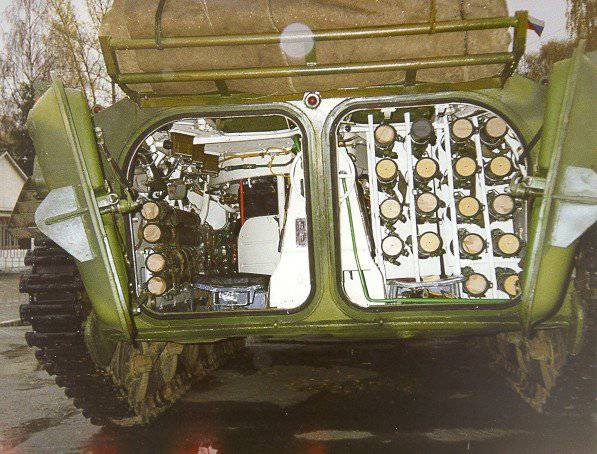
Aft of the car, the doors are open. Fasteners for flamethrowers and bundles with a complex of comfortable life support are visible. Photo Gurkhan.blogspot.ru
As part of the tracked armored vehicle there are six small diameter road wheels on each side. Skating rinks are equipped with an individual torsion suspension. In addition, the first, second and sixth pairs of rollers receive additional telescopic hydraulic shock absorbers. In front of the hull drive wheels are placed in the stern - guides. To maintain the upper branches are used several rollers of small diameter. The upper branch of the caterpillar is also covered by a small height side screen. A special grid is provided in its stern section, which provides movement through water by rewinding the tracks.
The flamethrower combat vehicle retains the turret and main armament of the BMP-2. In a double turret and under-turret space there is a complex of machine-gun and other weapons. In addition, as part of the BMO-1 project, the use of some new systems was proposed. The main built-in weapon of the armored vehicle is the 2-42 automatic caliber 30 mm, mounted on a rocking installation in the central part of the turret. 7,62-mm PKT machine gun is paired with a gun. Such a composition of weapons allows you to attack manpower or unprotected enemy equipment at ranges up to 3,5-4 km. The defeat of lightly armored cars produced at distances of about 1-1,5 km. There is also the possibility of firing at low-speed low-altitude air targets, which is facilitated by the possibility of vertical pickup in the range from -5 ° to + 74 °.
The 2А42 cannon ammunition consists of two types of 500 projectiles with the ability to quickly change the projectile used in accordance with the characteristics of the target. In the boxes for the machine gun ammunition is placed tape on 2000 cartridges.
According to reports, during the creation of the BMO-1, it was decided to abandon the use of guided missile weapons. Base BMP-2 has the ability to use anti-tank missile complex 9K911 "Fagot" or 9K911-1 "Competition". The flamethrower combat vehicle did not receive such weapons. This is probably due to the need to install other systems for other purposes. So, on the site of the missile system control systems could be installed other units of equipment proposed for use with new weapons.
The project BMO-1 proposes the use of two launchers for incendiary smoke cartridges ZDP. These devices are mounted on the front of the sides of the tower and are designed for firing ahead. Each launcher is a structure consisting of two support plates with 12 50 mm caliber holes, arranged in two vertical rows of six pieces. In the openings of the two plates are placed cartridges ZDP. For firing installation uses an electric ignition system. Fire control is carried out using a push-button console installed in the fighting compartment. Access to the console from the commander's and gunner's workplaces is provided. Ready-to-use ammunition incendiary smoke cartridges consists of 24 pieces. The same number of spare cartridges is stored in a special bag inside the fighting compartment. Reloading of launchers is carried out manually, for which the crew needs to leave the limits of the protected manned volume, remove the spent corps of cartridges and install new ZDP in their place.
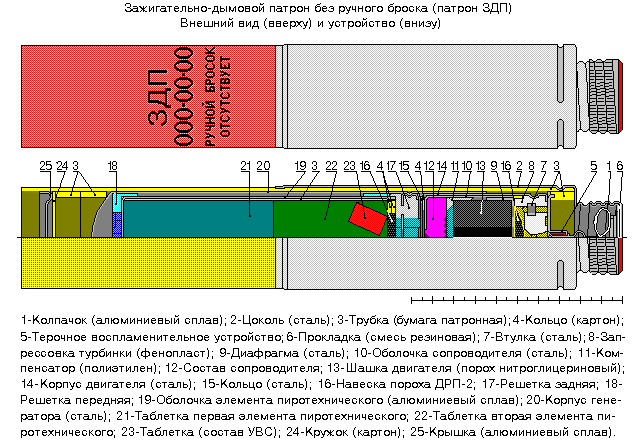
Scheme of incendiary smoke cartridge ZDP. Figure Dzromon.narod.ru
The ZDP cartridge is designed to ignite highly flammable materials or to quickly install smoke screens. The cartridge is a product with a tubular body inside which a propellant charge with an initiating device and a capsule with an aerosol-forming pyrotechnic composition are placed. The cartridge has a caliber of 50 mm and a length of 287 mm, weight - 750 g. It is provided by shooting the capsule at a distance of 500 m. For the formation of a smoke screen up to 15 m the composition of the capsule requires about 90 c.
In terms of combat use, the flamethrower combat vehicle is an infantry fighting vehicle designed to support flamethrower units. In accordance with this idea, the troop compartment of the base BMP-2 in the BMO-1 project is undergoing significant changes. Infantry fighting vehicle has a double row arrangement of six paratroopers with access through two stern doors. The need to transport the flamethrower unit led to a reduction in the number of landing places. After a corresponding modernization, only the seats in the left half of the troop compartment remain in their places. The fighters still have the opportunity to observe and shoot from personal weapons with the help of embrasures located in the optical devices.
The right half of the troop compartment of the BMO-1 machine does not receive seats for the fighters. Instead, there are several holding devices for transporting flamethrowers. Directly behind the door and at some distance from the opening, the project proposes to mount a set of vertical posts with restraints and locks for fixing flame throwers. The weapon fastened in its place is located parallel to the axis of the machine, and the ends of the products are brought to the aft door. In the existing volume it was possible to place mounts for 18 weapons. 16 flamethrowers are mounted in the form of a square 4x4, two more are placed under them, at the starboard side of the hull. In addition, a vertical rack for four flame throwers is provided at the left side of the hull, next to the landing places. Thus, the maximum ammunition flamethrowers consists of 22 products.
In accordance with the initial design of the BMO-1, the assault force of the machine as the main weapon for hitting various targets was to use the RPM Bumblebee infantry flamethrowers. This development of the Instrument Engineering Design Bureau, which was put into service in the eighties, is intended to defeat fortifications, manpower and lightly armored enemy vehicles. The main elements of the "Bumblebee" are the transport and launch container, the projectile and its engine. The assembled product has a length of 920 mm and an outer diameter of slightly more than 100 mm. Product weight - 11 kg. The flamethrower is a one-time and after the shot is not subject to recharge.
Ammunition RPO "Bumblebee" is a metal cylinder of the required volume with the tail spread in flight, providing stabilization by rotation. The release of ammunition from the container with acceleration to the desired speed is carried out using a powder engine. During the shot, the engine pushes the ammunition forward, but remains inside the launch canister. There are three modifications of the flamethrower, which differ in the type of ammunition equipment. The RPO-A product is equipped with a thermobaric warhead, the RPO-3 receives incendiary, and the RPO-D is equipped with smoke munitions. The target firing range is 600 m. In the case of RPO-A ammunition, the 2,1 kg of fire mixture, the detonation of which is equivalent to the explosion of 2,5 kg of TNT, is delivered to the target.
The authors of the project BMO-1 not only achieved an increase in firepower, but also took care of the comfort of the crew and the landing. In the stern of the roof of the combat vehicle, it was proposed to mount a relatively simple lattice basket. It is intended for transportation of various property from the so-called. life support package for the crew. A tent of the required capacity, a stove, sleeping bags, inflatable mattresses and a stand for drying shoes are placed in the basket. In the transport state, all elements of the complex are placed in a bundle, placed in the feed basket and secured with straps. With its help, the crew and flamethrowers, not being able to return to the barracks, have the opportunity to sit comfortably on a halt or to spend the night.
The dismantling of some units and the installation of others did not lead to a change in the overall weight and overall parameters of the combat vehicle. The length of the BMO-1 is 6,74 m, width - 3,15 m, height - 2,06 m. Combat weight - 14,2 t. Mobility parameters also remained at the level of the base BMP-2. The maximum speed on the highway is limited to 65 km / h, the power reserve is 300 km. The design of the machine and its chassis allows you to overcome water obstacles by swimming using rewinding tracks.
In accordance with the idea of the authors of the new project, from the point of view of the combat work, the flamethrower machine should have resembled the use of existing BMP-2. At the same time, however, certain differences were present related to the different composition of the weapons of the vehicle itself and its landing force. Thus, the task of the BMO-1 is to deliver four flame throwers to the battlefield, after which they must dismount and attack the detected targets using Bumblebee products. The crew of armored vehicles, in turn, must protect flamethrowers from various threats with the help of a gun and a machine gun. If necessary, can be used incendiary smoke cartridges.
The characteristic features of the RPO Bumblebee flamethrower give the combat vehicle several advantages over the BMP-2. First of all, flamethrowers allow you to more effectively attack the enemy fortifications. The main weapon of an infantry fighting vehicle in the form of an 30-mm automatic cannon has limited capabilities in dealing with buildings, etc. objects. Thermobaric warhead RPO projectile was originally created to defeat such targets. With a direct hit into the embrasure of reinforcement, the thermobaric explosion is guaranteed to destroy the enemy inside it, with a certain miss - it has a significant effect. There may also be certain advantages in the fight against infantry in open areas, for which a machine gun is usually used.
During the theoretical study and testing of finished equipment, it was found that the BMO-1 with four paratroopers from the point of view of the effectiveness of combat work far exceeds the "standard" BMP-2 with seven arrows. On the offensive, as well as during the transition to defense in unprepared positions or for an offensive, the flamethrower fighting machine is on average three times more effective than the BMP-2. In terms of defense, on prepared positions, the increase in efficiency was slightly lower. The main factor in the growth of efficiency was incendiary smoke cartridges, which ensured the possibility of a sudden creation of a smoke screen in the path of the enemy, after which the crew and troops, using his confusion, can strike or overpower. When reducing the number of troops, this advantage is achieved with the help of other weapons with higher power indices.
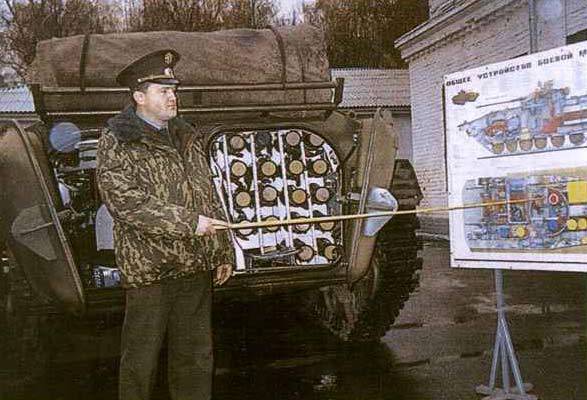
Personnel training is underway. Visible part of the scheme of the internal device BMO-1. Photo Btvt.narod.ru
According to the results of research and testing, it was found that the potential of the BMO-1 is most fully revealed when conducting offensive operations, when the crew and the airborne forces distribute different types of targets among themselves, for which different weapons are required. Of particular interest is the flamethrower fighting machine in operations in urban environments where armored vehicles are particularly threatened and have reduced capabilities to counter it. Flamethrowers in this case become a very convenient means of fire support and protection of military vehicles.
According to reports, the BMO-1 flamethrower combat vehicle, together with the heavy BMO-T, was brought to the testing stage in the late nineties of the last century. The equipment passed all the necessary checks, after which it was approved by the military department. According to the results of state tests, a prospective model of armored vehicles was recommended for use. The corresponding order appeared 4 April 2001. Soon after, the industry ordered the delivery of a number of serial machines. The exact order quantity and quantity of serial produced BMO-1, unfortunately, is unknown. Probably, RCBZ troops received no more than a few dozen armored vehicles.
With the help of two projects of BMO-1 flamethrowers and BMO-T combat vehicles, the Russian defense industry managed to solve a major problem. Previously, flamethrowing units of the radiation, chemical and biological defense forces were forced to use the same types of equipment as ground forces. However, armored personnel carriers and infantry fighting vehicles of the existing models in the original "infantry" configuration do not fully correspond to the specifics of the combat work of flamethrower. At the end of the nineties, two new equipment projects were created, initially created taking into account the peculiarities of the work of the RCBZ troops.
Together with the new equipment, separate divisions of the troops were able to increase the effectiveness of combat work in different conditions by increasing the ammunition of flame-throwing weapons and placing them more comfortably on armored vehicles. In addition, an additional advantage of the BMO-1 was the presence of launchers for incendiary smoke cartridges. As shown by studies conducted earlier, the processing of the design and methods of using existing armored vehicles made it possible to increase its effectiveness by several times, even after reducing the number of troops.
The only serious drawback of the BMO-1 machine can be considered the use of a rather old base chassis, which already does not fully meet the requirements of the time. However, even in this form, the flamethrower combat vehicle can accomplish the assigned tasks, delivering troops to the battlefield, hitting various targets with cannon, machine-gun or flame-throwing weapons, and, if necessary, installing smoke screens.
On the materials of the sites:
http://btvt.narod.ru/
http://russianarms.ru/
http://kbptula.ru/
http://gurkhan.blogspot.ru/
http://dzromon.narod.ru/
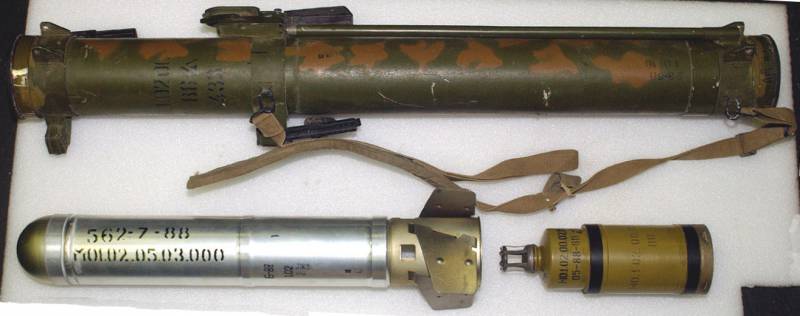
Information